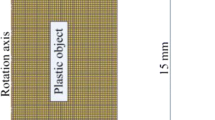Abstract
Investigation of failure of Dual Phase steels on the basis of the developed concurrent cellular automata finite element model is the subject of the present paper. Physical background of phenomena responsible for failure in these steels is described first. Then details of the developed random cellular automata model are presented. Particular attention is put on proper definition of the transition rules describing initiation and propagation of fractures across the microstructure. Finally combined cellular automata finite element model is established. Examples of obtained results are also presented within the paper.
Access this chapter
Tax calculation will be finalised at checkout
Purchases are for personal use only
Preview
Unable to display preview. Download preview PDF.
Similar content being viewed by others
References
Asgari, A., Ghadbeigi, H., Pinna, C., Hodgson, P.D.: Multiscale modelling of stress and strain partitioning in high strength dual phase steels. Computer Methods in Materials Science (12), 163–174 (2012)
Avramovic-Cingaraa, G., Ososkov, Y., Jain, M.K., Wilkinson, D.S.: Effect of martensite distribution on damage behaviour in DP600 dual phase steels. Materials Science and Engineering A 516, 7–16 (2009)
Beynon, J.H., Das, S., Howard, I.C., Palmier, E.J., Shterenlikht, A.: The combination of cellular automata and finite elements for the study of fracture; the CAFE model of fracture. In: ECF14 - 14th European Conference on Fracture, Krakow, 241–248 (2002)
Calcagnotto, M., Adachi, Y., Ponge, D., Raabe, D.: Deformation and fracture mechanisms in fine- and ultrafine-grained ferrite/martensite dual-phase steels and the effect of aging. Acta Materialia 59, 658–670 (2011)
Hayami, S., Furukawa, T.: A family of high, cold-rolled steels. In: Microalloying Strenght 1975 (1975)
Madej, L.: Digital Material Representation of Polycrystals in Application to Numerical Simulations of Inhomogeneous Deformation. Computer Methods in Materials Science 10, 1–13 (2010)
Madej, L.: Realistic description of dual phase steel morphology on the basis of the Monte Carlo method. Computer Methods in Materials Science 12(3), 197–206 (2012)
Madej, L., Krużel, P., Cybułka, P., Perzyński, K., Banaś, B.: Generation of dedicated finite element meshes for multiscale applications with Delaunay triangulation and adaptive finite element - cellular automata algorithms. Computer Methods in Materials Science 12(2), 85–96 (2012)
Madej, L., Mrozek, A., Kuś, W., Burczyński, T., Pietrzyk, M.: Concurrent and upscaling methods in multi scale modelling - case studies. Computer Methods in Materials Science 8(1), 1–15 (2008)
Perzyński, K., Madej, L.: Numerical analysis of influence of the martensite volume fraction on DP steels behavior during plastic deformation. Archives of Metallurgy and Materials 58(1), 211–215 (2013)
Rauch, L., Madej, L.: Application of the automatic image processing in modelling of the deformation mechanisms based on the digital representation of microstructure. International Journal for Multiscale Computational Engineering 8(3), 343–356 (2010)
Shterenlikht, A., Howard, I.: The CAFE model of fracture - application to a TMCR steel. Fatigue and Fracture of Engineering Materials and Structures 29(9-10), 770–787 (2006)
Sieradzki, L., Madej, L.: A perceptive comparison of the cellular automata and Monte Carlo techniques in application to static recrystallization modeling in polycrystalline materials. Computational Materials Science 67, 156–173 (2013)
Szyndler, J., Madej, L.: Effect of number of grains and boundary conditions on digital material representation deformation under plane strain. Archives of Civil and Mechanical Engineering (2013) (in press)
The GIMP Documentation, GIMP (2013), http://docs.gimp.org/ (retrieved August 14, 2013)
Vajragupta, N., Uthaisangsuk, V., Schmaling, B., Münstermann, S., Hartmaier, A., Bleck, W.: A micromechanical damage simulation of dual phase steels using XFEM. Computational Materials Science (54), 271–279 (2012)
Author information
Authors and Affiliations
Editor information
Editors and Affiliations
Rights and permissions
Copyright information
© 2014 Springer International Publishing Switzerland
About this paper
Cite this paper
Perzy, K., Sitko, M., Madej, Ł. (2014). Numerical Modelling of Fracture Based on Coupled Cellular Automata Finite Element Approach. In: Wąs, J., Sirakoulis, G.C., Bandini, S. (eds) Cellular Automata. ACRI 2014. Lecture Notes in Computer Science, vol 8751. Springer, Cham. https://doi.org/10.1007/978-3-319-11520-7_17
Download citation
DOI: https://doi.org/10.1007/978-3-319-11520-7_17
Publisher Name: Springer, Cham
Print ISBN: 978-3-319-11519-1
Online ISBN: 978-3-319-11520-7
eBook Packages: Computer ScienceComputer Science (R0)




